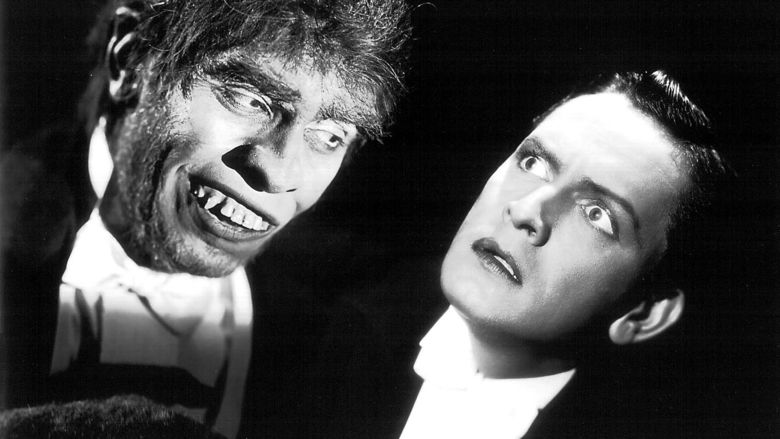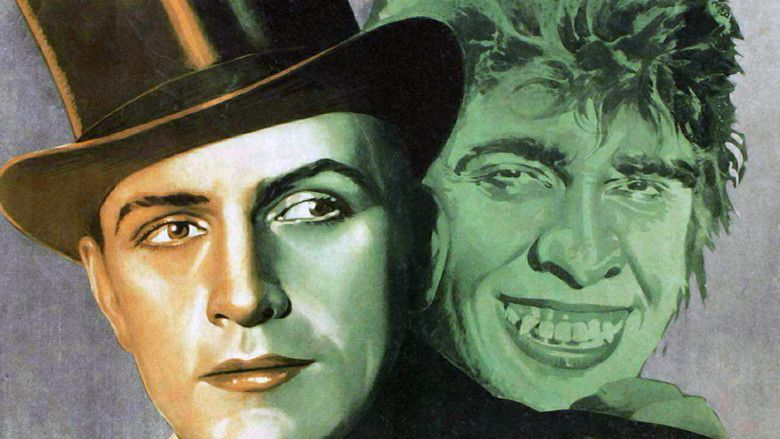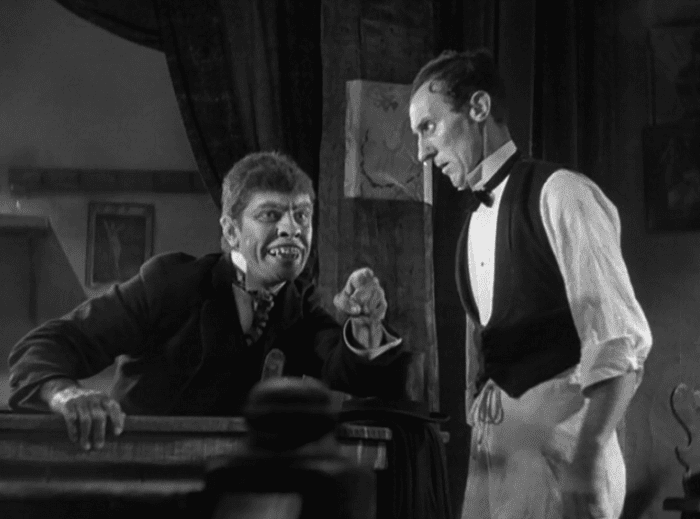Dr Jekyll and Mr Hyde (1931 film)
8.6 /10 1 Votes
93% Rotten Tomatoes Genre Horror, Sci-Fi Duration Country United States | 7.7/10 IMDb Budget 1.14 million USD Language English | |||||||||||||||||||||||||||||||||
 | ||||||||||||||||||||||||||||||||||
Release date December 31, 1931 (1931-12-31) Adapted from Strange Case of Dr Jekyll and Mr Hyde Cast (Dr. Jekyll / Mr. Hyde), (Ivy Pearson), (Muriel Carew), (Dr. Lanyon), (Brigadier-General Sir Danvers Carew), (Poole) Similar movies You Only Live Twice , Dr. No , For Your Eyes Only , The Living Daylights , The Man with the Golden Gun , The Spy Who Loved Me Tagline Put yourself in her place! The dreaded night when her lover became a madman! | ||||||||||||||||||||||||||||||||||
Dr. Jekyll and Mr. Hyde is a 1931 American pre-Code horror film, directed by Rouben Mamoulian and starring Fredric March, who plays a possessed doctor who tests his new formula that can unleash people's inner demons. The film is an adaptation of The Strange Case of Dr Jekyll and Mr Hyde, the 1886 Robert Louis Stevenson tale of a man who takes a potion which turns him from a mild-mannered man of science into a homicidal maniac. March's performance has been much lauded, and earned him his first Academy Award.
Contents
- Dr jekyll and mr hyde 1931 changing into hyde
- Plot
- Cast
- Production
- Theatrical release
- Box office
- Critical reception
- Awards and honors
- References

Dr jekyll and mr hyde 1931 changing into hyde
Plot

The film tells the story of Dr. Henry Jekyll (Fredric March), a kind English doctor in Victorian London, who is certain that within each man lurks impulses for both good and evil. One evening, Jekyll attends a party at the home of his fiancée Muriel Carew (Rose Hobart), the daughter of Brigadier General Sir Danvers Carew (Halliwell Hobbes). After the other guests have left, Jekyll informs Sir Danvers that, after speaking to Muriel, he wants Carew's permission to push up their wedding date. Sir Danvers sternly refuses Jekyll's request. Later, while walking home with his colleague, Dr. John Lanyon (Holmes Herbert), Jekyll spots a bar singer, Ivy Pierson (Miriam Hopkins), being attacked by a man outside her boarding house. Jekyll drives the man away and carries Ivy up to her room to attend to her. Ivy begins flirting with Jekyll and feigning injury, but Jekyll fights temptation and leaves with Lanyon.

Muriel and Sir Danvers leave London for a few months. In the meantime, Jekyll develops a drug that releases the evil side in himself, thus becoming the violent Edward Hyde. Along with his behavior, Dr. Jekyll's appearance changes as well. He transforms into something more menacing and primitive looking. Unlike Dr. Jekyll, Hyde has no conscience, no restrictions, no boundaries; he is free to do what he pleases. Hyde returns to the music hall where Ivy works, and offers to tend to her financial needs in return for her company. Hyde manipulates Ivy into accompanying him by terrorizing her, being violent, controlling and torturing her psychologically. He remains at her boarding house until he finds out that Muriel and her father are returning to London, and leaves Ivy but threatens her that he'll be back.
On advice from her landlady Mrs. Hawkins (Tempe Pigott), Ivy goes to see Dr. Jekyll, hoping that he can free her of the abusive Hyde. When she arrives, Ivy sees that the celebrated Dr. Jekyll was the same man who saved her from abuse just months before. She breaks down in tears over her situation with Hyde. Jekyll is extremely distraught over the pain that he (Hyde) has caused her and promises Ivy that she will never have to worry about Hyde again.

While on his way to a party at the Carews' home to celebrate their return and the announcement of a new wedding date to Muriel, Jekyll, without the use of his drugs, suddenly changes into Hyde. Ivy, who thought she was free of Hyde forever, is terrified when Hyde appears before her. Hyde angrily confronts her about seeing Jekyll and, just before murdering her, reveals that he and Jekyll are one and the same.

Hyde escapes and heads back to Jekyll's house but his servant Poole refuses to open the door. Desperate, Hyde writes a letter to Lanyon from Jekyll instructing Lanyon to get certain chemicals and have them waiting for him at Lanyon's home. When Hyde arrives, Lanyon pulls a gun on him and demands that Hyde take him to Jekyll. Hyde tells Lanyon that Jekyll is safe, but Lanyon doesn't believe him and refuses to let him leave. Realizing there is not much time, Hyde drinks the formula in front of Lanyon. Lanyon is shocked to witness the transformation and tells his friend that he has practically damned his soul for tampering with the laws of God. Lanyon also advises Jekyll that the transformation that happened that night will happen again eventually.

With Ivy's murder, Sir Danvers' anger towards him for missing the party, and Hyde's persona beginning to dominate his own, Henry Jekyll's life continues to spiral out of control. He later goes to the Carews' where Sir Danvers coldly rejects his visit but Muriel welcomes him. Jekyll, realizing the monster he really is, tells Muriel that he cannot be with her anymore. He feels that he is already damned and fears that he will harm her. He decides to leave. Standing out on the terrace and tearfully watching Muriel cry, Jekyll begins to change into Hyde once again. He then reenters the Carew house through the terrace door and assaults Muriel. Her screams bring her father and their butler, Hobson. Hyde then viciously murders Sir Danvers out in the garden by striking him repeatedly with Jekyll's cane until it breaks, then runs off into the night towards Jekyll's home and the lab to mix a new formula to change himself back.

The police and Lanyon are standing over Carew's body in the garden. Recognizing the broken cane found next to the body, Lanyon tells them that he knows whose cane that is and agrees to take them to its owner. The police later arrive at Jekyll's lab looking for Hyde and find only Jekyll, who lies that Hyde has escaped. They begin to leave when Lanyon arrives and tells them that Jekyll is the man they're searching for (because the man they are looking for is hiding inside him). Just then a nervous Jekyll begins changing into Hyde before their shocked eyes. Outraged at Lanyon for betraying him, Hyde leaps from behind the table and attacks him. Hyde then tries to escape from the police but is fatally shot before he can again hurt Lanyon. As Hyde lies dead on the table full of Dr. Jekyll's experiments and potions, he transforms one last time back into Henry Jekyll.
Cast

Production
The film was made prior to the full enforcement of the Production Code and is remembered today for its strong sexual content, embodied mostly in the character of the bar singer, Ivy Pierson, played by Miriam Hopkins. When it was re-released in 1936, the Code required 8 minutes to be removed before the film could be distributed to theaters. This footage was restored for the VHS and DVD releases.
The secret of the transformation scenes was not revealed for decades (Mamoulian himself revealed it in a volume of interviews with Hollywood directors published under the title The Celluloid Muse). Make-up was applied in contrasting colors. A series of colored filters that matched the make-up was then used which enabled the make-up to be gradually exposed or made invisible. The change in color was not visible on the black-and-white film.
Wally Westmore's make-up for Hyde — simian and hairy with large canine teeth — influenced greatly the popular image of Hyde in media and comic books. In part this reflected the novella's implication of Hyde as embodying repressed evil, and hence being semi-evolved or simian in appearance. The characters of Muriel Carew and Ivy Pierson do not appear in Stevenson's original story but do appear in the 1887 stage version by playwright Thomas Russell Sullivan.
John Barrymore was originally asked by Paramount to play the lead role, in an attempt to recreate his role from the 1920 version of Jekyll and Hyde, but he was already under a new contract with Metro-Goldwyn-Mayer. Paramount then gave the part to March, who was under contract and who strongly resembled Barrymore. March had played a John Barrymore-like character in the Paramount film The Royal Family of Broadway (1930), a story about an acting family like the Barrymores. March would go on to win the Academy Award for Best Actor for his performance of the role.
When Metro-Goldwyn-Mayer remade the film 10 years later with Spencer Tracy in the lead, the studio bought the negative and the rights to both the Mamoulian version and the earlier 1920 version, paying $1,250,000. They then recalled every print of the film that they could locate and for decades most of the film was believed lost. Ironically, the Tracy version was much less well received and March jokingly sent Tracy a telegram thanking him for the greatest boost to his reputation of his entire career.
The opening credits use Toccata and Fugue in D minor, BWV 565 by Johann Sebastian Bach.
Theatrical release
The film was the first film to be screened at the first edition of the Venice International Film Festival.
Box office
Grossing $1.25 million, the film was a box office hit on par with the Universal monster films of the era, even considering that its $535,000 budget was high for a horror film at the time.
Critical reception
Dr. Jekyll and Mr. Hyde was received mostly positive reviews upon its release. Mordaunt Hall of The New York Times wrote an enthusiastic review, comparing it favorably to the John Barrymore version as a "far more tense and shuddering affair" than that film. Hall called March "the stellar performer" in the title role while praising the acting of the entire supporting cast as well, and called the old-fashioned atmosphere created by the costumes and set designs "quite pleasing".
Film critic Leonard Maltin gave the film 3 out of a possible 4 stars, calling it "exciting", and "floridly cinematic", also praising March's and Hopkins performances.
Variety ran a somewhat less favorable but still positive review. Alfred Rushford Greason wrote that "the picture doesn't build to an effective climax" because it was too slow and labored in getting there, and that while the initial transformation sequence "carries a terrific punch", its effect became lessened with successive uses. However, Greason credited March with "an outstanding bit of theatrical acting", declared the makeup "a triumph", and said that the sets and lighting alone made the film worth seeing "as models of atmospheric surroundings."
John Mosher of The New Yorker reported that the film "has its full storage of horror" and was "well acted". March, he wrote, "gives us a Mr. Hyde as athletic and exuberant as might have been that of Douglas Fairbanks, Senior." Film Daily declared: "Gripping performance by Fredric March is highlight of strong drama, ace supporting cast and direction".
Film review aggregator Rotten Tomatoes reported an approval rating of 93%, based on 27 reviews, with a rating average of 8.3/10. The site's critical consensus reads, "A classic. The definitive version of the Robert Louis Stevenson novella from 1931, with innovative special effects, atmospheric cinematography and deranged overacting."
Awards and honors
Wins
Nominations
Other honors
The film is recognized by American Film Institute in these lists:
References
Dr. Jekyll and Mr. Hyde (1931 film) WikipediaDr. Jekyll and Mr. Hyde (1931 film) IMDbDr. Jekyll and Mr. Hyde (1931 film) Rotten TomatoesDr Jekyll and Mr Hyde (1931 film) themoviedb.org
